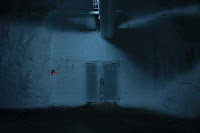Time to Open the Vault
 |
| A frost-covered door inside the Svalbard Global Seed Vault |
Actually, blogging about THE VAULT is part of my intricate strategery for getting the script done. I'll never solve the mystery of what this movie is really about. But rather than conduct the investigation entirely inside my own head, I'm making it slightly more public. After all, I've been inside my head for over 40 years. It's crowded in there. And frankly, I'm a bit sick of it.
For those of you who don't know the basic premise of THE VAULT, here's a little background. A "seed vault," or "gene bank," is a site for storing the seeds of agriculture. Nearly every country on Earth has at least one seed vault. Our own National Center for Genetic Resources Preservation is based in Fort Collins, Colorado. The purpose is to have a secure central storage place for the seeds that your country uses to grow things. These seeds represent a huge chunk of a nation's economy. Because after all, from seeds come the raw materials of not only food, but also clothing and shelter.
About five years ago, an American named Cary Fowler decided to do something on a grander scale: lead the construction of the world's first "global seed vault," containing backup copies of all the seeds stored in the national vaults. Why? Because genetic diversity in food-bearing plants is shrinking just as it's growing critically important. The math is highly unfavorable. Global population is skyrocketing, which will continue to put tremendous strains on our food supply. And yet the tools for growing that food supply are quickly dwindling.
Why is this important? Because plant genes form the "palette" from which you can develop fruit, vegetable, grain, legume, nut and rice strains that can survive extreme weather conditions and stave off nasty insects or fungi. To form a clumsy double-metaphor, it just so happens that when it comes to plant-based food, putting all your eggs on one basket can burn you. The Irish learned this in 1845, when the Phytophthora infestans fungus killed the tuber potato crop on which they had become totally dependent (also known as the Potato Famine). If you don't have the genetic palette to plant or create new resistant varieties of a plant ... and you're dealing with massive global climate change that affect soils, water supplies and the presence and migrations of fungi and bugs ... then you're basically on a road to disaster.
How much has our genetic palette diminished over the last hundred years? Consider this: A century ago, U.S. seed banks contained 307 varieties of sweet corn. Today, there are 12. I took that from this graphic, which should scare you.
So Cary Fowler's ("Fowler is an anagram for "flower," BTW ... go figure) Global Seed Vault was born in 2008 in the Norwegian town of Spitsbergen, which sits on the chain of arctic islands known at Svalbard, just 600 miles from the North Pole. Drilled 500 feet into a mountain, the vault is approaching 1 million seed varieties from around the world. It has already helped replenish seed banks in places like Iraq and Afghanistan (our wars led to looting) and the Philippines (flood and fire has destroyed existing depositories). Svalbard is built in a low-seismic, volcano-free zone, where the climate is amenable to preserving seeds and surviving nuclear war, the complete melting of the polar ice caps, and even an asteroid strike.
So back to my script. It started with a simple idea: What if the construction crew that was building the Svalbard seed vault stumbled on an existing vault in the exact same place, filled with seeds that no one has ever seen before? And that, my friends, is where the story begins.


Comments